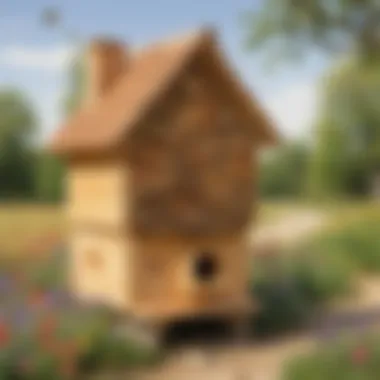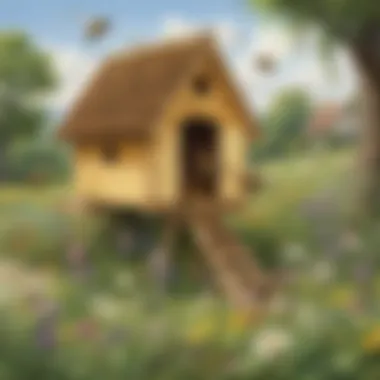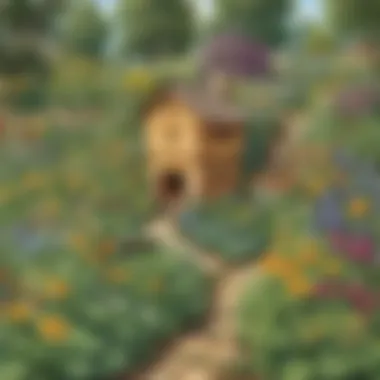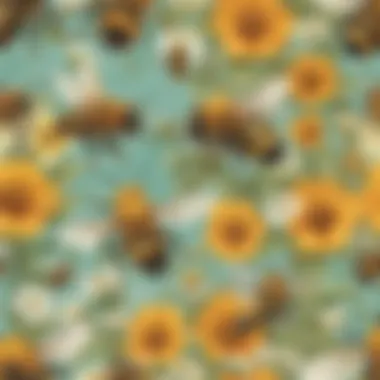Unlocking the Eco-Wonders of Small Bee Houses: A Young Scientist's Ultimate Guide


Science Fun Facts
Small bee houses are like tiny hotels for our buzzing friends, the bees. These structures provide a safe and comfortable space for bees to rest, nest, and pollinate flowers, playing a crucial role in maintaining biodiversity.
Discover the Wonders of Science
By setting up small bee houses in your garden, young nature enthusiasts can witness the fascinating world of bees up close. Observing bees buzzing in and out, carrying pollen, offers a hands-on lesson in the importance of these tiny creatures to our ecosystem.
Science Quiz Time
How many different species of bees do you think can benefit from a small bee house? A) 2, B) 5, C) 10, D) 20. Test your knowledge on bee habitats and discover more about these incredible pollinators through interactive quizzes and brain teasers.
Science Experiment Showcase
Get ready for a hands-on science experiment by creating your mini bee house. Follow the step-by-step instructions, gather the necessary materials like bamboo tubes, wood, and a cozy shelter, and don't forget to prioritize safety by wearing gloves and avoiding any harmful substances.
Introduction
Small bee houses are essential components in supporting biodiversity and pollinators. In this comprehensive guide designed for young Science Enthusiasts, we delve into the significance of these structures in nurturing the ecosystem and fostering a deeper connection with nature. By understanding the role of bees and the benefits of small bee houses, budding scientists can explore the wonders of creating a sustainable habitat that supports the vital work of these tiny creatures.
The Fascinating World of Bees
Bees play a crucial role in maintaining the delicate balance of ecosystems. The importance of bees in ecosystems lies in their role as pollinators. Through the transfer of pollen from one flower to another, bees enable the reproduction of plants, ensuring the biodiversity of flora. This process is vital for the survival of many plant species, highlighting the interconnectedness of living organisms in nature.
The role of pollination in plant life underscores the significance of bees in sustaining plant diversity. Pollination is essential for the production of fruits, seeds, and other plant structures, contributing to the growth and regeneration of various plant species. Bees' specialized pollination techniques enhance the efficiency of this process, making them invaluable contributors to the ecosystem.
Understanding Small Bee Houses


Definition and purpose are core aspects of small bee houses that young science enthusiasts should grasp. These structures serve as shelters for solitary bees and other bee species, providing them with a safe space to nest and hibernate. The key characteristic of small bee houses is their ability to mimic natural bee habitats, offering bees a conducive environment for reproduction and development.
The benefits of providing bee habitats extend beyond creating a safe shelter. By offering small bee houses in outdoor spaces, individuals contribute to the conservation of bee populations and support pollination activities. These habitats attract bees to gardens, increasing pollination rates and fostering plant growth. The unique feature of small bee houses lies in their ability to enhance biodiversity while engaging individuals in environmental stewardship.
The Habitat of Bees
Bee habitats are crucial elements in maintaining biodiversity and supporting pollinators, such as bees. Providing a suitable environment for bees to thrive is essential for the ecosystem's balance. By understanding the types of bees and their nesting habits, individuals can make informed decisions when creating bee-friendly spaces.
Types of Bees and Their Nests
Solitary Bees
Solitary bees are a distinctive type of bee that may not live in colonies like honeybees. They prefer to build individual nests where each female bee takes care of her offspring. Solitary bees play a vital role in pollination due to their solitary lifestyle, ensuring diverse plant fertilization. These bees are a favorable choice for bee houses, as their independent nature simplifies habitat maintenance. Despite their solitary behavior, they contribute significantly to the pollination process, enhancing the overall biodiversity of the area.
Honeybees and Bumblebees
Honeybees and bumblebees are social bees that live together in colonies. They exhibit complex social structures and exhibit a high level of organization within their hives. The distinctive characteristic of honeybees and bumblebees lies in their ability to store honey and regulate hive temperature through collective efforts. In this article, understanding the nesting behaviors of honeybees and bumblebees becomes crucial for creating appropriate habitats. While their social nature provides benefits such as efficient pollination, it also requires specific considerations, such as providing ample space for hive expansion and ensuring a continuous nectar supply.
Creating a Bee-Friendly Environment
When establishing a bee-friendly environment, selecting the right location is paramount. Bees thrive in areas with abundant food sources and minimal pesticide exposure. Choosing a location with diverse flowering plants ensures a stable nectar supply throughout the seasons. Additionally, creating a bee-friendly garden involves selecting materials that are safe and conducive to bee nesting. Opting for natural, untreated wood and designing bee houses with proper ventilation are essential factors to consider when building a small bee habitat.
Materials for Building a Small Bee House
The materials used in constructing a small bee house significantly impact the habitat's success. Wooden structures provide insulation and protection against the elements, creating a comfortable environment for bees to nest. Utilizing eco-friendly materials that do not contain chemicals harmful to bees is crucial for their well-being. Incorporating nesting materials such as bamboo tubes or paper straws offers varied options for bees to establish their nests. Furthermore, ensuring proper drainage and maintaining cleanliness within the bee house are essential for promoting a healthy bee population.
Building Your Small Bee House


In this crucial section of our guide on small bee houses, we illuminate the significance of constructing your bee abode. Building your small bee house is a pivotal step in supporting biodiversity and pollinator populations. By providing a safe and conducive environment for bees, you contribute to the conservation of these essential creatures. Creating a small bee house involves meticulous planning and execution to ensure its effectiveness in sheltering and nurturing bees.
Step-by-Step Guide
Gathering Materials
Diving into the specifics of gathering materials for your bee house, it is essential to procure sturdy and weather-resistant substances. Selecting materials such as untreated wood, bamboo, and recycled plastics is advantageous due to their durability and eco-friendliness. These materials offer insulation and protection against external elements, ensuring the longevity of your bee house. The unique feature of these materials lies in their sustainability and ability to withstand environmental pressures, making them ideal choices for constructing a durable bee habitat.
Assembling the Bee House
When it comes to assembling the bee house, attention to detail is paramount. Each component must be securely attached to guarantee the structural integrity of the habitat. The key characteristic of proper assembly is creating a safe and functional space for bees to nest and thrive. Utilizing precise measurements and following assembly instructions diligently are beneficial practices that ensure the structural stability of the bee house. The unique feature of a well-assembled bee house is its capacity to provide a secure environment while enabling easy access for maintenance and observation. Careful assembly minimizes the risks of damage and disturbance to bee inhabitants, fostering a harmonious coexistence within the habitat.
Decorating and Enhancing the Bee Habitat
Planting Bee-Friendly Flowers
Enhancing the bee habitat with bee-friendly flowers is a critical aspect of fostering a sustainable ecosystem. Planting nectar-rich flowers such as lavender, sunflowers, and coneflowers provides a valuable food source for bees while beautifying the surroundings. The key characteristic of these flowers is their alluring fragrance and vibrant colors, attracting bees and enhancing pollination activities. Incorporating a diverse range of flowers ensures continuous bloom throughout the seasons, catering to the varying needs of different bee species. The unique feature of these flowers lies in their ability to harbor beneficial insects and promote a healthy floral environment.
Adding Water Sources
Another essential element in enriching the bee habitat is integrating water sources within the vicinity. Bees require access to water for hydration and regulating hive temperature, making water sources a vital component of their habitat. Providing shallow dishes with pebbles or floating vegetation enables bees to drink safely without the risk of drowning. The key characteristic of these water sources is their accessibility and safety measures, ensuring bee welfare and promoting regular hydration. The unique feature of incorporating water sources is their contribution to sustaining bee populations and fostering a balanced ecosystem.
Maintaining Your Bee Habitat
Maintaining Your Bee Habitat is a crucial aspect in the realm of small bee houses, contributing significantly to the well-being of these essential pollinators. Regular monitoring and care ensure that the bee habitat remains conducive for their sustenance and activity. By checking for bee activity regularly, one can gauge the health and vibrancy of the bee population residing in the small bee house. This process involves observing the comings and goings of bees, monitoring pollen collection, and noting any irregularities that might indicate potential issues that need attention.
Apart from monitoring, cleaning and maintenance are vital components of maintaining a bee-friendly environment. Regularly cleaning the bee house removes debris, pests, and mold that could endanger the bees. Providing maintenance involves repairing any damages, ensuring the structural integrity of the bee house, and replenishing nesting materials. By adhering to these practices, one can foster a healthy and thriving bee habitat that supports pollination and biodiversity.


Regular Monitoring and Care
Checking for Bee Activity
Checking for Bee Activity is a fundamental task in maintaining a bee habitat as it offers insights into the well-being and productivity of the bees. By observing bee activity, one can assess their behavioral patterns, foraging habits, and overall population dynamics within the bee house. This helps in identifying any signs of distress, disease, or decline in numbers, allowing for timely intervention to mitigate potential risks to the bee population and their habitat.
The key characteristic of Checking for Bee Activity lies in its simplicity yet effectiveness in monitoring bee health. It serves as an early warning system to detect any anomalies or changes in bee behavior, prompting appropriate action for safeguarding the bee community. Its unique feature is its non-invasive nature, enabling observers to gather valuable information without disrupting the bees' natural routines, making it a preferred method for monitoring bee activity in small bee houses.
Cleaning and Maintenance Tips play a pivotal role in preserving the functionality and appeal of bee-friendly gardens. Regular cleaning removes accumulated dirt, ensuring a hygienic environment for the bees. Maintenance tips include repairing any damages, repainting or sealing wooden structures, and replacing worn-out nesting materials. A well-maintained bee habitat not only provides a safe haven for bees but also contributes to the overall aesthetics of the garden, creating a harmonious blend of nature and human intervention.
Expanding Your Bee-Friendly Garden
Adding Nesting Sites
Adding Nesting Sites is an essential step in expanding a bee-friendly garden, offering additional shelter and breeding grounds for solitary bees and other pollinators. By incorporating diverse nesting options such as hollow twigs, bamboo tubes, or nesting boxes, gardeners can attract a wider array of bee species, enhancing the garden's pollination potential. The key characteristic of Adding Nesting Sites lies in its ability to encourage nesting diversity, promoting species richness and ecological balance within the garden ecosystem.
Adding Nesting Sites is a popular choice for garden enthusiasts seeking to support bee populations and enrich the biodiversity of their outdoor spaces. Its unique feature lies in its flexibility, allowing for customization based on bee preferences and garden design, thus catering to specific bee species' nesting requirements. This feature makes Adding Nesting Sites a versatile and adaptable strategy for creating bee-friendly environments in various settings.
Diversifying Plant Varieties is a key aspect of promoting biodiversity and attracting a wider range of pollinators to the garden. By planting an assortment of flowering plants with varying colors, shapes, and blooming periods, gardeners can provide ample food sources for bees throughout the seasons. Diverse plant varieties not only enhance the visual appeal of the garden but also ensure a continuous supply of nectar and pollen for bees, supporting their nutritional needs and reproductive cycles.
Diversifying Plant Varieties offers numerous advantages in terms of ecosystem resilience and pollination efficiency. By planting a mix of native and non-native plants, gardeners can create a rich tapestry of resources that cater to different bee species' preferences. This approach fosters a dynamic and thriving garden ecosystem, where pollinators play a vital role in sustaining plant diversity and ecological balance.
Conclusion
In the fast-paced environment of modern beekeeping, the significance of small bee houses cannot be overstated. As we wrap up our comprehensive guide for budding Science Enthusiasts, it is crucial to reflect on the pivotal role that small bee houses play in the intricate web of nature. These small, unassuming structures serve as vital sanctuaries for solitary bees and other pollinators, enhancing biodiversity and ensuring the survival of countless plant species. By providing a safe haven for these tiny creatures, we are fostering a sustainable ecosystem that thrives on interconnectedness and mutualistic relationships. The diligence and care invested in maintaining small bee houses ultimately contribute to the larger tapestry of the environment, emphasizing the importance of every small action in shaping a thriving world for all beings.
Appreciating the Impact of Small Bee Houses
Promoting Biodiversity
Promoting biodiversity through small bee houses is a fundamental aspect of conservation efforts worldwide. These miniature abodes attract a diverse array of pollinators, ranging from solitary bees to honeybees and bumblebees, enriching the ecosystem with their unique contributions. The key characteristic of promoting biodiversity through small bee houses lies in the ability to create a microcosm of life within a confined space, showcasing the resilience and adaptability of nature in adapting to human-made habitats. This approach not only benefits the immediate surroundings but also serves as a crucial stepping stone in restoring balance to ecosystems disrupted by urbanization and agricultural practices. The unique feature of promoting biodiversity through small bee houses lies in its simplicity yet profound impact, offering a glimpse into the wonders of nature's resilience and the symbiotic relationships that sustain life on our planet.
Supporting Pollinators
Supporting pollinators through the provision of small bee houses is a cornerstone of sustainable gardening practices that prioritize environmental stewardship. By creating conducive habitats for bees and other pollinators, we are safeguarding the intricate process of pollination that underpins agricultural productivity and plant diversity. The key characteristic of supporting pollinators with small bee houses lies in the symbiotic relationship between humans and bees, where each party benefits from the other's presence and activities. This mutualistic bond not only ensures the pollination of flowers and crops but also highlights the interdependence of all living organisms in a delicate dance of survival and propagation. The unique feature of supporting pollinators with small bee houses is the tangible impact it has on local ecosystems, fostering resilience and adaptability in the face of environmental challenges and species decline.







